You’re working with molten metal that reaches temperatures of 800°C or higher, where a single mistake can result in severe burns requiring an average 17-day hospital stay. Equipment failure causes over 35% of foundry accidents, while toxic fume exposure threatens your long-term health. Moisture near molten metal can trigger explosive steam bursts, and heat exhaustion adds another dangerous layer. Following safety protocols isn’t optional—it’s your lifeline in an environment where proper preparation determines whether you’ll go home safely each day.
Understanding the Risks Associated With Molten Metal Handling
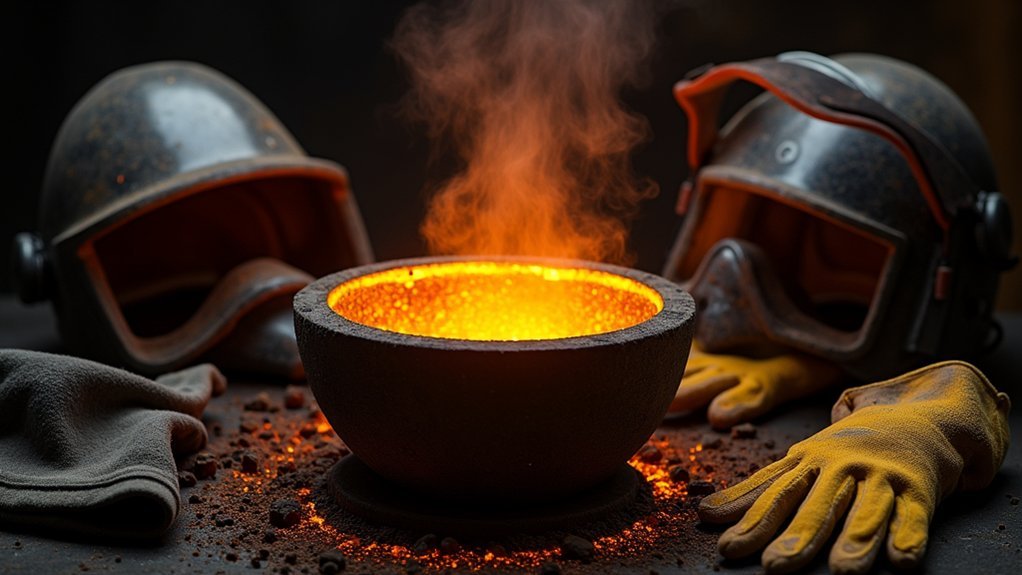
When working with molten metal that reaches approximately 800°C, you’re facing serious hazards that demand your complete attention.
Burns represent the most severe risk, with victims averaging 17-day hospital stays when just 2.7% of their body surface is affected. You’ll also encounter safety hazards including eye damage and toxic gas inhalation during casting processes.
Even minor burns from molten metal result in extended hospitalizations, while eye injuries and toxic fumes create additional severe health risks.
Equipment failure causes 272 out of 773 reported casting accidents, making regular maintenance critical.
Moisture near molten metal creates explosive steam bursts, so you must maintain completely dry environments. Heat exhaustion poses additional threats in these high-temperature conditions.
Your protection depends on proper personal protective equipment (PPE) and continuous safety training.
Understanding these risks isn’t optional—it’s essential for preventing life-threatening injuries.
Implementing Comprehensive Hazard Identification and Risk Assessment
You’ll need to systematically identify all potential hazards in your foundry, from molten metal splatter to toxic fume exposure, ensuring nothing’s overlooked in your assessment process.
Equipment failure causes over 35% of foundry accidents, so you must establish rigorous inspection schedules and maintenance protocols for furnaces, ladles, and protective systems.
Your thorough risk assessment should prioritize these critical hazards based on severity and likelihood, enabling you to allocate resources effectively and implement targeted prevention strategies.
Identifying Critical Metal Hazards
Although metal casting operations present numerous workplace dangers, implementing a systematic hazard identification and risk assessment process enables you to pinpoint and prioritize the most critical threats before they cause harm.
During the metal casting process, you’ll face severe burns from molten metal that can hospitalize victims for an average of 17 days. Equipment failure causes 272 out of 773 casting accidents, making machinery assessments essential safety precautions.
You must also recognize toxic gas inhalation risks and potential eye damage from handling molten materials. Through thorough hazard identification, you’ll determine which risks pose the greatest threats to your workplace.
This systematic approach allows you to develop tailored safety protocols that proactively address the most dangerous aspects of metal casting operations.
Equipment Failure Prevention Strategies
Since equipment failure accounts for over one-third of casting accidents, you must establish a robust prevention strategy that combines regular maintenance with systematic hazard assessment.
Regular maintenance checks prevent equipment failure that’s linked to 272 out of 773 accidents in metal casting operations. You’ll need thorough hazard identification and risk assessment to spot potential equipment issues before they cause accidents.
Implement routine inspections to maximize equipment efficiency while reducing costly breakdowns and production delays. Through visual inspections, you can detect mechanical issues early, preventing equipment malfunction accidents that endanger workers.
When you establish a proactive maintenance culture alongside proper protective clothing and safety measures, you’ll extend machinery lifespan while greatly minimizing equipment failure risks.
Establishing Mandatory Personal Protective Equipment Requirements
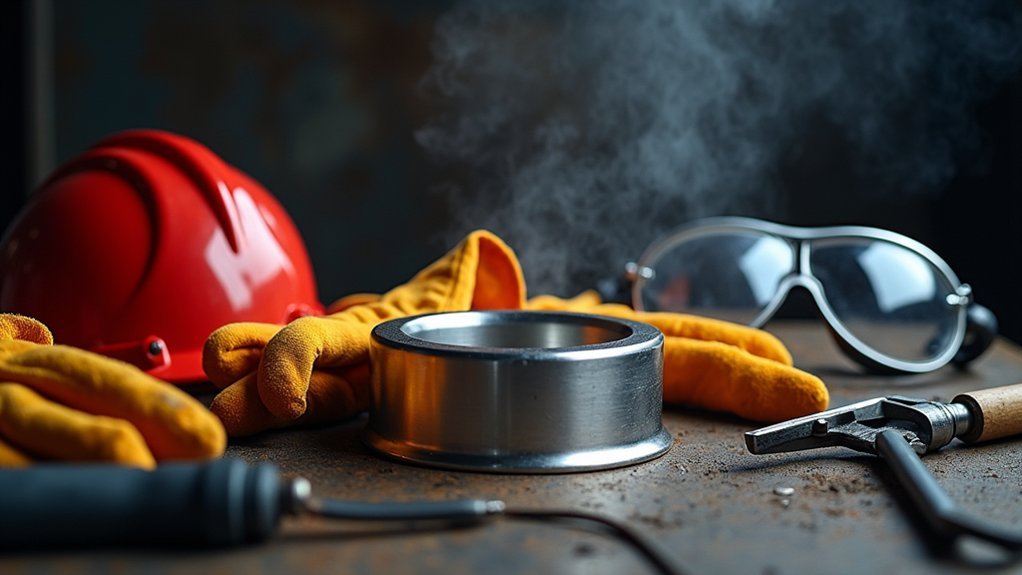
When working with molten metal that reaches temperatures of approximately 800°C, you’ll need extensive personal protective equipment to prevent severe burns and injuries.
Your employer must conduct thorough risk assessments to determine appropriate PPE requirements for your casting foundry operations.
Essential protective gear includes thick gloves, heat-resistant boots, long pants, face shields, and specialized aluminized apparel designed to protect against radiant heat and molten splash.
- Thick gloves and heat-resistant boots protect extremities from direct contact with hot surfaces
- Face shields and protective sleeves guard against molten metal splashes and intense radiant heat
- Aluminized apparel provides thorough protection in high-temperature foundry environments
Proper safety training guarantees you understand how to use and maintain your Personal Protective Equipment effectively, creating a safer workplace culture.
Developing Ongoing Safety Training and Education Programs
You’ll need to establish annual training requirements that keep your team current on evolving safety standards and casting procedures.
Your program must include specific modules for heat stress recognition, teaching workers to identify early warning signs and implement protective measures during high-temperature operations.
You should also mandate equipment operation certification for all machinery handlers, ensuring they’re qualified to safely operate foundry equipment and respond to emergency situations.
Annual Training Requirements
While technical skills form the foundation of metal casting expertise, thorough annual safety training serves as the critical barrier between workers and potentially life-threatening hazards.
You’ll need extensive ongoing training that covers industry standards, heat stress recognition, and dust hazard identification. This systematic approach reduces workplace accidents and keeps you updated on evolving safety protocols.
Your annual training requirements should include:
- Technical safety protocols – Proper handling procedures for molten metal and equipment operation
- Protective equipment training – Correct usage, maintenance, and inspection of safety gear
- Emergency response drills – Practice scenarios for equipment failures and molten metal exposure
Regular safety drills prepare you for real emergencies, enhancing your response capabilities.
Continuous education creates informed workers who actively identify and mitigate risks, ultimately improving workplace safety outcomes.
Heat Stress Recognition
Since metal casting environments expose workers to extreme temperatures that can quickly overwhelm the body’s cooling mechanisms, you must develop thorough heat stress recognition programs that enable early identification of dangerous symptoms.
Your safety training should teach employees to spot signs like excessive sweating, dizziness, nausea, and confusion in themselves and coworkers. You’ll create a supportive workplace when workers monitor each other for heat exhaustion and heat stroke indicators.
Provide specialized first aid training for heat-related emergencies so your team can respond immediately.
Implement cooling stations with hydration access and scheduled rest breaks in shaded areas. While protective equipment is essential, you must balance protection with heat management.
Regular program updates keep your heat stress recognition training current with best safety practices.
Equipment Operation Certification
Beyond protecting workers from heat-related dangers, your metal casting operation requires extensive equipment operation certification programs that validate each worker’s competency before they handle dangerous machinery.
These structured programs guarantee operators understand proper Personal Protective Equipment (PPE) requirements and safe operational techniques through hands-on practice.
Annual safety training sessions keep your workforce current with evolving regulations and industry standards. Workers must demonstrate their understanding of safe practices before certification approval, fostering accountability throughout your operation.
Key certification program components include:
- Structured curriculum combining theoretical knowledge with practical equipment operation experience
- Regular recertification requirements guaranteeing continued competency and safety awareness
- Hazard recognition training enabling workers to identify and respond effectively to potential dangers
Continuous education initiatives minimize equipment-related accidents while maintaining compliance with safety protocols.
Creating Emergency Preparedness and Response Procedures
Although metal casting operations involve inherently dangerous processes, you can greatly reduce risks by developing thorough emergency preparedness and response procedures.
Start by establishing clear protocols for heat-related incidents, positioning first aid kits and hydration stations within easy reach of workers. Your safety training should include regular drills that prepare employees for potential hazards, creating a culture where quick response becomes second nature.
Regular emergency drills and accessible safety equipment transform workplace hazard response from reactive scrambling into instinctive, life-saving actions.
Implement reliable communication channels for emergency alerts so all workers receive immediate notifications.
Develop an extensive response plan covering various scenarios like chemical spills or equipment failures. Your safety protocols must include regular reviews and updates based on incident assessments and employee feedback, ensuring continuous improvement in your emergency preparedness systems.
Maintaining Strict Moisture Control in Casting Environments
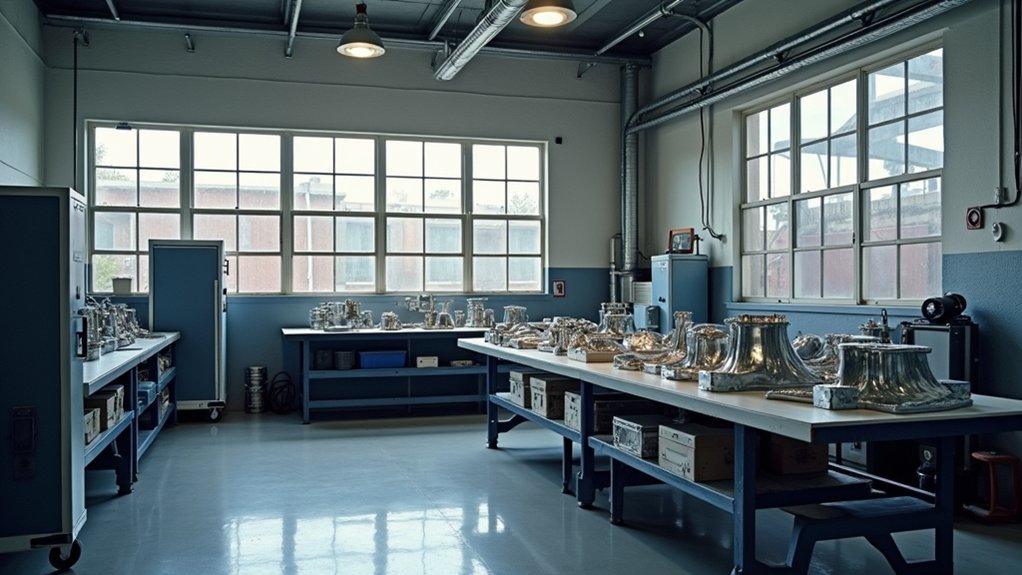
When molten metal at temperatures around 800°C encounters even small amounts of moisture, it creates explosive steam bursts that can cause severe injuries and equipment damage.
You must implement thorough moisture control throughout your entire casting operation to prevent these dangerous reactions.
Proper moisture control requires systematic attention to every aspect of your workspace.
You’ll need to warm metal ingots before adding them to the melting crucible, eliminating any trapped moisture that could cause violent steam reactions.
Store all sand materials in moisture-tight containers to prevent contamination.
Essential moisture control practices include:
- Keeping all safety equipment and tools completely dry before use
- Conducting regular facility inspections for moisture sources and leaks
- Maintaining proper ventilation to reduce ambient humidity levels
These protocols greatly reduce accident risks while protecting your equipment investments.
Recognizing and Preventing Heat Stress in Workers
Working near molten metal exposes you to extreme temperatures that can quickly overwhelm your body’s natural cooling systems, making heat stress recognition and prevention critical for your safety.
You must recognize the signs of heat stress, including excessive sweating, dizziness, and fatigue. These symptoms can escalate rapidly from heat exhaustion to life-threatening heat stroke without prompt intervention.
Comprehensive safety training should teach you to monitor yourself and coworkers for these warning signs. You’ll need consistent access to hydration stations throughout your workspace, encouraging frequent water intake to prevent dehydration.
Proper safety training ensures workers monitor heat stress symptoms while maintaining consistent hydration through strategically placed water stations.
Your facility should implement cooling measures like air-conditioned break areas or cooling vests during high-temperature operations. Regular temperature monitoring and scheduled breaks help mitigate prolonged heat exposure risks, ensuring your protection during demanding casting work.
Implementing Regular Machinery Inspection and Maintenance Protocols
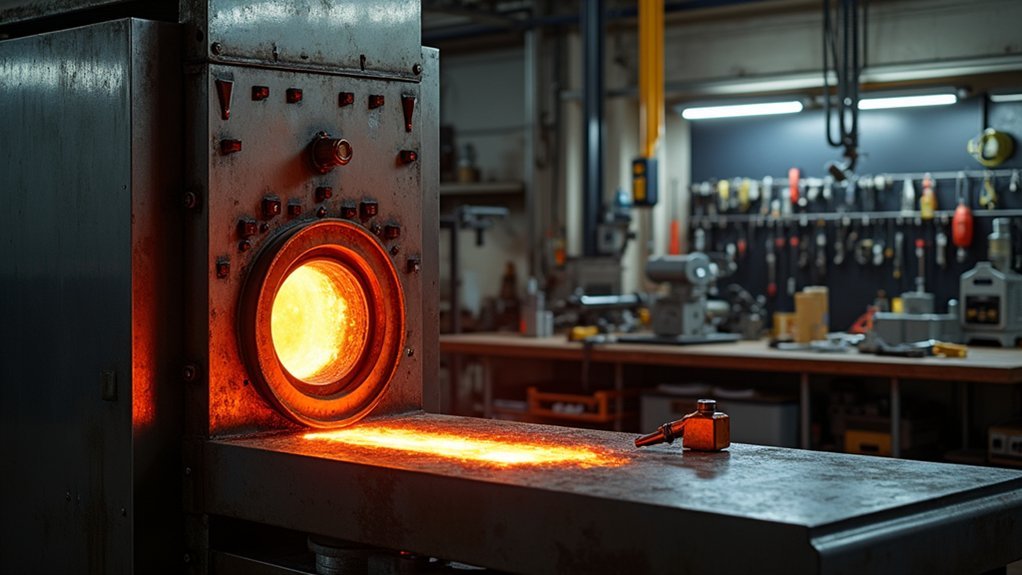
Beyond protecting workers from heat-related injuries, you must maintain the machinery that operates in these extreme conditions to prevent equipment failures that compromise safety.
Regular machinery inspection directly impacts worker safety, as equipment failure caused 272 out of 773 foundry accidents. You’ll maximize equipment efficiency and prevent costly breakdowns by implementing consistent maintenance protocols.
- Conduct visual inspections to detect surface defects and gas evolution that create dangerous casting situations
- Establish proactive maintenance culture for early detection of mechanical issues, extending machinery lifespan
- Provide thorough manual handling training to guarantee safe equipment operation and minimize misuse accidents
These maintenance protocols help identify potential hazards while reducing casting defects and production delays, creating a safer working environment for everyone involved.
Managing Dust Exposure and Respiratory Hazards
You’ll face significant respiratory hazards from metal dust particles during casting operations, making effective dust management critical for worker safety.
Your foundry needs robust dust control systems that capture airborne particles at their source and maintain clean air throughout the workspace.
You must also provide proper respiratory protection equipment to guarantee workers don’t inhale harmful dust when engineering controls aren’t sufficient.
Dust Control Systems
When casting metal, dust particles become airborne and pose serious respiratory threats to workers, making robust dust control systems non-negotiable for foundry safety.
You’ll need quality ventilation equipment that captures and filters harmful particles generated during metal casting processes. These systems greatly improve air quality by preventing dust accumulation in your workspace.
However, dust control systems alone aren’t sufficient. You must also provide Personal Protective Equipment (PPE) like respirators to workers as an additional safety layer.
Regular cleaning schedules complement your dust collection systems to maintain ideal working conditions.
Key components for effective dust management include:
- Continuous monitoring of dust levels for regulatory compliance
- Strategic placement of ventilation equipment near casting operations
- Scheduled maintenance of filtration systems
Respiratory Protection Equipment
While dust control systems form your foundry’s first line of defense, respiratory protection equipment serves as the critical personal barrier between workers and harmful airborne particles.
You’ll need high-quality respirators specifically designed for dust protection, as metal casting generates silica and other toxic substances that can cause serious occupational lung diseases.
Your Personal Protective Equipment (PPE) program must include proper training so workers recognize dust exposure dangers and understand correct respirator usage.
Even with proper ventilation systems in place, you can’t rely solely on environmental controls. Regular dust level assessments help verify your respiratory protection equipment remains effective against workplace hazards.
Controlling Noise Levels and Preventing Hearing Damage
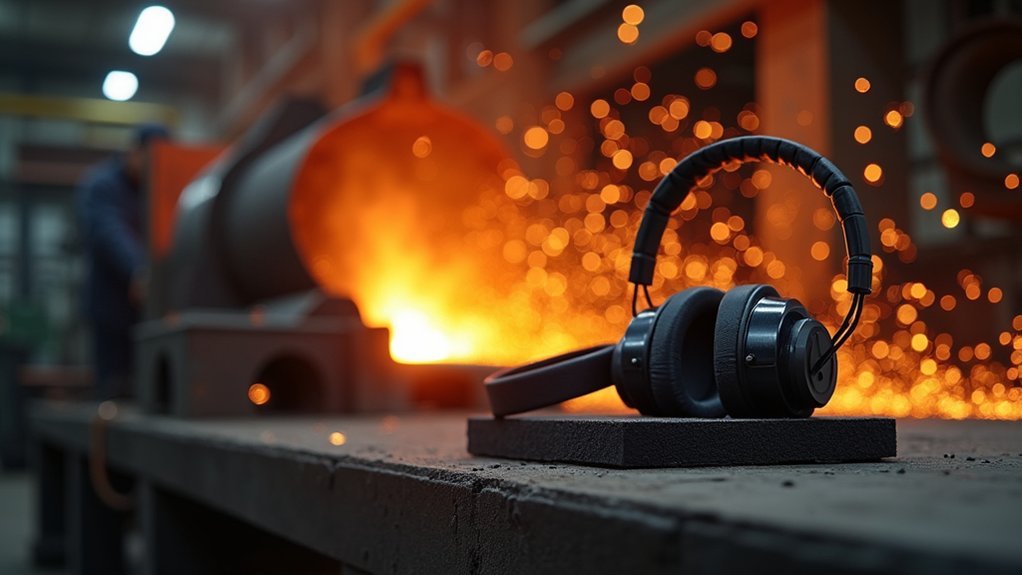
Although foundry operations generate significant noise hazards, you can protect your hearing and maintain a safer work environment through proper noise control measures.
Casting processes like shakeouts create excessive noise that causes permanent hearing loss without proper management. You’ll need regular assessments of noise levels within your facility to guarantee compliance with safety regulations.
Engineering controls prove more effective than Personal Protective Equipment (PPE) for noise reduction. Focus on installing noise-dampening equipment rather than relying solely on hearing protection.
You can also implement administrative controls by scheduling noisy tasks during less busy periods.
- Install engineering controls like noise-dampening equipment for maximum effectiveness
- Schedule noisy operations during off-peak hours to minimize worker exposure
- Conduct regular noise assessments to maintain compliance and prevent hearing damage
Handling Chemical and Electrical Hazards Safely
You’ll face significant chemical and electrical hazards during metal casting operations that require immediate attention and proper protocols.
Your safety depends on implementing strict chemical storage procedures, following thorough electrical safety measures, and using appropriate worker protection equipment.
These three critical areas work together to create a protective barrier between you and potentially life-threatening workplace dangers.
Chemical Storage Protocols
Because foundries rely on numerous hazardous chemicals for metal casting processes, establishing robust chemical storage protocols becomes critical for worker safety and operational integrity.
You must guarantee all chemicals are clearly labeled and stored in designated, well-ventilated areas away from heat sources. Secure these areas from unauthorized access to prevent accidental exposure or mishandling.
- Keep Safety Data Sheets readily available for all chemicals, providing essential hazard information and emergency procedures.
- Store hazardous materials in appropriate containers with proper containment measures to prevent spills and environmental contamination.
- Maintain regular inventory checks and guarantee Personal Protective Equipment (PPE) is accessible near storage areas.
Implementing these chemical storage protocols protects your workforce while maintaining compliance with safety regulations and reducing liability risks.
Electrical Safety Measures
While chemical hazards pose significant risks in foundries, electrical dangers present equally serious threats that demand your immediate attention and extensive safety measures.
You must implement strict electrical safety protocols that include routine inspections of all electrical systems and equipment to identify potential shock risks before accidents occur.
Your workers need thorough safety training to recognize electrical hazards and follow established protocols.
Make sure they’re equipped with appropriate Personal Protective Equipment (PPE), including insulated gloves and protective eyewear designed specifically for electrical protection.
You should establish clear emergency procedures for electrical incidents to reduce response times during critical situations.
Regular maintenance of electrical equipment and proper grounding systems are essential components of your overall electrical safety strategy in the foundry environment.
Worker Protection Equipment
Three fundamental categories of worker protection equipment form the cornerstone of foundry safety: chemical-resistant gear, electrical protection devices, and respiratory equipment.
You’ll need chemical-resistant gloves and aprons to prevent chemical exposure from harmful substances in casting processes. Insulated tools and electrical Personal Protective Equipment (PPE) protect you from shock risks during operations.
Your safety training must include proper PPE selection and usage protocols. Regular updates guarantee you’re informed about latest best practices and regulations in foundry environments.
Essential protective equipment includes:
- Chemical-resistant gloves, aprons, and goggles for handling hazardous substances
- Insulated tools and electrical protection gear to prevent shock incidents
- Respiratory equipment designed for foundry environments and chemical vapors
Compliance with safety regulations notably reduces workplace incidents, creating a safer environment for everyone involved in metal casting operations.
Establishing Proper Ventilation and Environmental Controls
When you’re casting metal, establishing robust ventilation and environmental controls isn’t just recommended—it’s absolutely crucial for protecting your health and preventing catastrophic accidents.
Proper ventilation systems swiftly remove harmful fumes that cause immediate health issues or long-term lung problems. You’ll need dedicated dehumidification systems to maintain moisture-free environments, preventing dangerous explosions when moisture contacts molten metal.
Implement regular cleaning schedules and dust control measures to minimize airborne particles that trigger respiratory problems.
Your ventilation system also regulates temperature, preventing worker overheating from extreme casting heat.
Don’t overlook environmental controls for compliance with emissions regulations—they guarantee responsible resource stewardship while reducing air quality health risks.
These systems work together to create safer working conditions.
Maintaining Clean and Organized Work Areas
Beyond implementing ventilation systems, maintaining clean and organized work areas forms the foundation of safe metal casting operations.
You’ll greatly reduce trip hazards and accident risks by keeping your foundry area tidy. Regular organization of tools guarantees easy access and prevents time delays that could compromise safety protocols.
Your working environment directly impacts operational efficiency and worker protection. When you keep the pouring area free from unnecessary items, you’ll maintain better focus and reduce contamination risks. Frequent clutter checks enhance visibility and communication among team members.
A clean, organized pouring area enhances worker focus, reduces contamination risks, and improves team communication during critical casting operations.
- Remove unnecessary items from pouring areas to prevent contamination and accidents
- Organize tools systematically for quick access and reduced misplacement risks
- Conduct regular workplace inspections to identify and eliminate potential hazards
This organization fosters a safety culture where everyone takes responsibility for their surroundings.
Building a Culture of Safety Through Communication and Accountability
While organized workspaces provide the physical foundation for safety, you’ll achieve lasting protection only when your entire team actively communicates risks and holds each other accountable.
In foundries where molten metal reaches 800°C, clear communication about hazards and protective measures becomes critical for every worker’s survival.
Regular safety audits and ongoing safety training programs guarantee everyone understands their responsibilities in maintaining a safe environment.
You should encourage open communication about safety concerns, allowing workers to report hazards and contribute improvements.
Instituting feedback platforms empowers employees to voice safety ideas, reinforcing shared accountability across your team.
This culture-focused approach doesn’t just reduce accident rates—it improves worker morale as employees feel valued and engaged in protecting each other’s well-being.
Frequently Asked Questions
What Are the Safety Hazards of Casting?
You’ll face severe burns from 800°C molten metal, eye damage, toxic gas inhalation, and hearing loss. Equipment failures cause numerous accidents, while moisture contact creates dangerous explosions that can seriously injure you.
What Are the Two Basic Safety Rules to Observe When Using Casting Processes?
You must always wear proper PPE including heat-resistant gloves and face shields, and keep all moisture away from molten metal to prevent dangerous explosions and severe burns.
Which of the Following Is a Safety Hazard Associated With Casting?
You’ll face multiple casting safety hazards including molten metal burns at 800°C, toxic fume exposure, explosive steam from moisture contact, inadequate PPE protection, and equipment failures causing 272 recorded accidents.
What Safety Precautions Should Be Followed When Working in a Foundry?
You should wear heat-resistant PPE, inspect equipment regularly, maintain moisture-free environments, receive annual safety training, and implement dust control measures to protect against burns, explosions, and respiratory hazards.
In Summary
You can’t afford to take shortcuts when casting metal. Your safety depends on following established protocols, wearing proper PPE, and maintaining constant vigilance around molten materials. By implementing thorough risk assessments, emergency procedures, and ongoing training, you’ll protect yourself and your coworkers from serious injuries. Remember, creating a strong safety culture isn’t optional—it’s essential for successful metalcasting operations and everyone’s well-being.

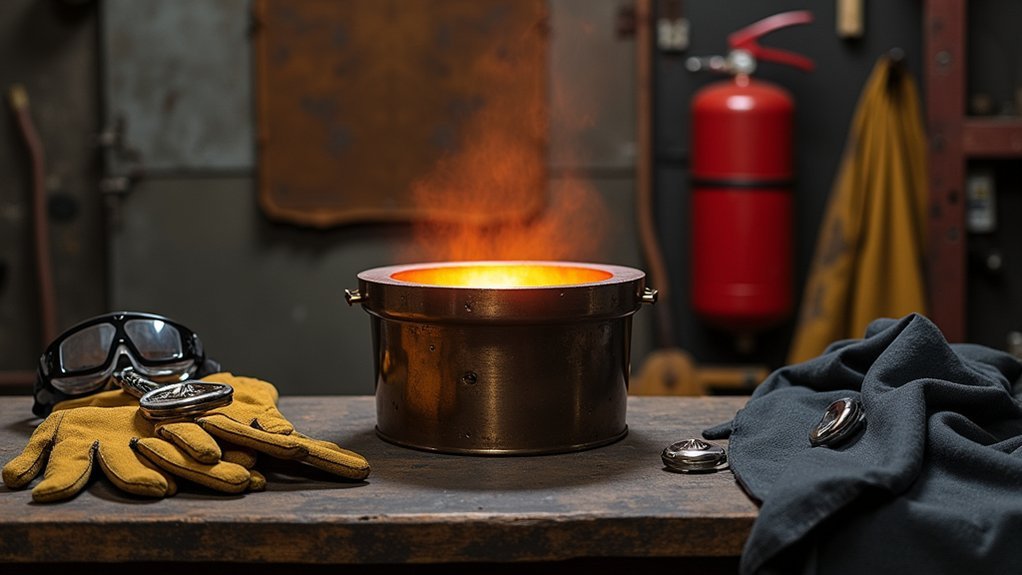



Leave a Reply